OSHA—Making the business case for safety:
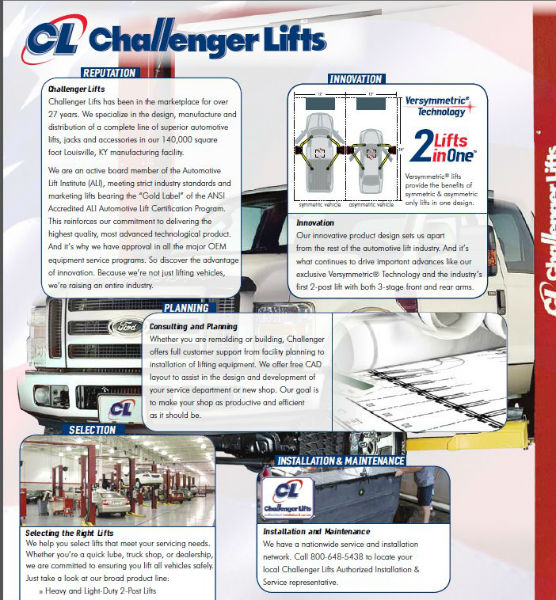 Automobiles have come
Automobiles have come
a long way in design,
workmanship and production
since Henry Ford rolled out
the first Model T in 1908. As
an advocate of innovation,
Ford would likely marvel at
today’s selection of vehicles,
technological advances,
and the many gadgets and
options that customers can
select to fit their needs and
preferences.
These four-wheeled
machines require qualified
engineers and mechanics
to understand the intricacies
of how they work. Though
today’s vehicles differ in
appearance and function to
some degree, the equipment
and tools to repair them are
virtually the same, and so are
the requirements for workplace
safety and health.
Automotive repair shop
employers must ensure
that their employees possess
and maintain a comprehensive
understanding of how to
operate their equipment and
follow procedures when working
with hazardous materials,
cleaning solvents and other
potentially dangerous fluids.
For example, aerial lifts,
sometimes called hydraulic
lifts or jacks, are used to lower
or raise work platforms or
objects of significant weight.
Automobile shops often use
lifts to elevate vehicles to
make repairs. Standing
underneath a 3,000-pound
mass of metal can be very
risky. Among other hazards,
mechanics face severe injury
if an improperly secured
aerial lift malfunctions.
According to the Bureau
of Labor Statistics, in 2005
there were 1.5 injury and illness lift-related incidents
for every 10,000 full-time
automotive repair and
maintenance employees. In
that same year, eight fatal
occupational injuries involving
jacks (lifts) occurred. In 2006,
the rate for lift-related
injury and illness incidents
increased to 4.6, while
the number of fatal occupational
injuries involving jacks
rose to 13.
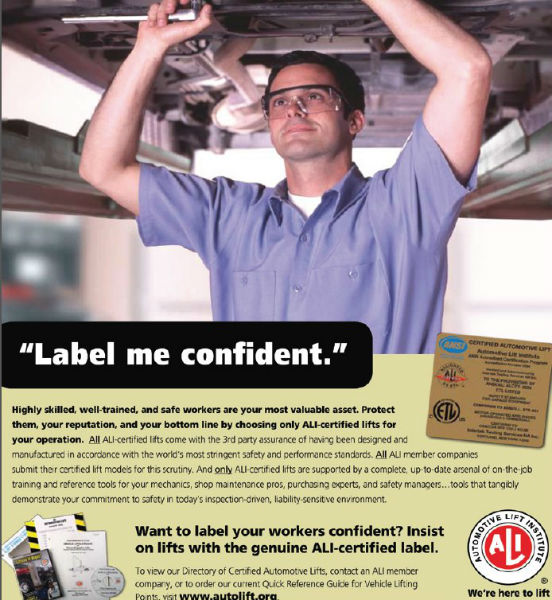 Our mission at OSHA is
Our mission at OSHA isto assure safe and healthful
working conditions for
America’s working men
and women. To accomplish
this mission, OSHA has
developed a wide variety of
resources to assist employers
and employees with the best
practices and most
effective approaches to
create and maintain a safe
work environment.
Businesses in the U.S.
incur an estimated cost
of $170 billion a year from
occupational injuries
and illnesses – about $1,300
per employee. Increases in
injuries and illnesses result in
higher workers’ compensation
costs, decreased
productivity, possible
government fines and legal
fees, and increased
employee turnover, all leading
to a negative impact on a
company’s bottom line. This
is not to be overshadowed
by the personal impact on
injured employees and their
families.
OSHA’s Safety and Health
Topics page, “Making the
Business Case for Workplace
Safety and Health”
(http://www.osha.gov/dcsp/
products/topics/
businesscase/index.html), highlights the significant
economic benefits employers
can achieve while also
fulfilling their safety and
health responsibilities. The
page provides free resources,
safety and health information
and case studies to help
employers succeed. Many
OSHA Alliance Program
participants contribute to
this topics page, sharing
their expertise and
experience to develop
valuable guidance and training
materials to reduce occupational
injuries and
illnesses.
Compliance with safety
and health requirements is
part of doing business the
right way. Employers will
find many useful resources
on OSHA’s Compliance
Assistance web page
(http://www.osha.gov/dcsp/
compliance_assistance/
index.html), including free
information on work-related
injury and illness prevention,
compliance with the
Occupational Safety and
Health Act, and OSHA’s
cooperative programs.
Businesses, such as
automobile repair shops and
distributors, can benefit from
OSHA’s Alliance and Onsite
Consultation Programs.
Through its Alliance with
OSHA, the Automotive Lift
Institute (ALI) has shared
its expertise in developing automotive
lift training courses;
safety tip cards and vehicle
lifting guides; and a Safety
Video Kit.
 Automotive lift safety
Automotive lift safety
As those familiar with
industrial safety issues well
know, Federal, state, and provincial
laws cited throughout
North America traditionally
lag behind industry consensus
standards. Surprising
examples of this can be seen
in the automotive industry as
it relates to important components
such as brake hoses
and safety glass. Closer to
home for a service technician
or shop owner, we find
that within the automotive lift
industry the National Safety
Standards are technically
known as “Voluntary
Consensus Standards”. In
general terms, this implies,
at least on the surface, that
unless an “authority having
jurisdiction” (AHJ) mandates
compliance, there are little
if any ramifications beyond
legal activity that can be
linked to knowingly producing
or offering a product that
fails to conform to the voluntary
consensus standard.
Consider this lag as it becomes
coupled with today’s
truly global economy, which
as most purchasers are now
aware from traditional consumer
examples, competes
more often on price and
volume with varying degrees
of compromise in quality. The
situation, as described, finds
seemingly reputable manufacturers
who are interested
in product safety, stuck in
the gap between choosing to
comply with the current voluntary
national safety standard
or building the product
to withdrawn
standards in order to comply
with an out of date regulation.
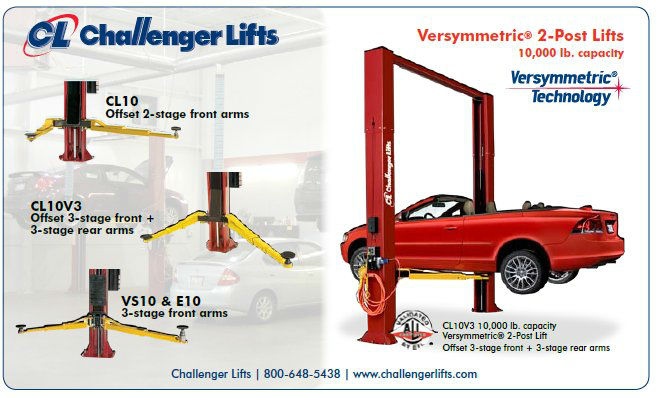 This seemingly tough
This seemingly toughsituation quickly becomes
exacerbated by constant
concern for the market’s
sensitivity to non compliant
product which, at first glance,
looks like a good deal for the
consumer. In my experience
to date, more times than not
these products are introduced
by import companies, web
based distributors, foreign
manufacturing and even
some North American based
companies - all of whom are
either unaware of current
standards activities and regulations
or they simply don’t
care because the lift industry
has not been on the radar of
regulatory and code enforcement
officials.
Fortunately, a new day
has dawned (so to speak)
in the area of automotive
lift safety. AHJs are beginning
to better understand the
importance of their roles and
of code enforcement within
the automotive service and
repair environment. They are
embracing the life saving
value associated with conducting
a detailed site assessment.
As noted previously
within this article, an AJH
by definition is the Authority
Having Jurisdiction – in plain
terms this is the individual or
entity holding the decision
making authority. With regard
to automotive lift
compliance, a national chain
typically has a designated
corporate AHJ who may be
an industrial Hygienist or
another form of corporate
health and safety officer who
sets policy to insure the organization
fully complies with
federal, state, regional, or, in
the case of operations taking
place in Canada, provincial
lift safety requirements.
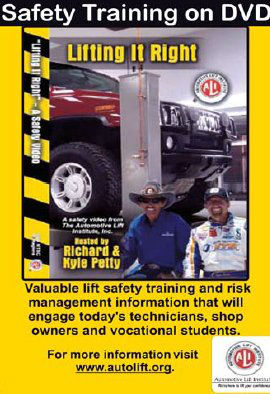 How does the AHJ gain the
How does the AHJ gain thepower to enforce
standards?
OSHA - The National
Technology Transfer and
Advancement Act (NTTA) of
1995 was signed into law on
March 7, 1996, it required
that all Federal agencies
use standards developed by
accredited voluntary consensus
standards bodies
instead of government-unique
standards whenever possible.
With regard to automotive lift
safety, this act allowed for the
withdrawal of the longstanding
Federal Specification
entitled “OO-L-360, Lift,
Motor Vehicle, Covering In-
Ground Automotive Lifts”.
Perhaps, more importantly,
it allowed OSHA to look
favorably on, and to begin
to reference those American
National Standards developed
in support of automotive
lift safety when acting to
investigate and issue citations
involving automotive
lifts. The basis for this action
is through the application of
OSHA’s General Duty Clause
[Section 5(a)(1)
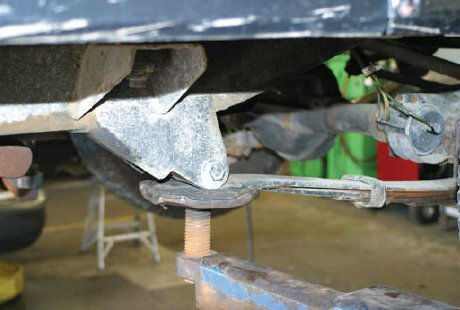 Where do you get your
Where do you get your
lift point information? When
you need to go under a
vehicle to diagnose or
perform required vehicle
service, where do you
obtain information for the
placement of the lift adapter
pads? Are you confident
your sources are reliable?
If you believe you haven’t
seen a vehicle you don’t
know how to lift or that
everything is just common
sense, you’re destined for
an accident. Don’t assume
that lifting is the same from
vehicle to vehicle.
Unfortunately, this is often
the statement heard from
experienced service technicians:
“It doesn’t matter if
it’s a roadster, an SUV, a 4x4
with duals, a two-door or
four-door family sedan, or
even a truck. All you have
to do is find a hard spot like
the frame or the jack points
on a unibody car. Sure, it’s
important if the hard spot
is flat and level but, in a
pinch, it’s okay to use the
spring hangers. They’re connected
to the frame aren’t
they? Some vehicle manufacturers
even tell you to lift
on the spring hangers.”
This is a risky assumption
and one likely to lead to an
accident.There’s quite a bit of
information out there, so how
do you know what to follow?
Bottom line, if one source
doesn’t seem quite right,
seek out another source and
always use good old common
sense! If something doesn’t
jibe with what you’re reading,
always question it. You are
your best safety source; don’t
ignore your own sensibilities.
Vehicle Lifting: Points to remember
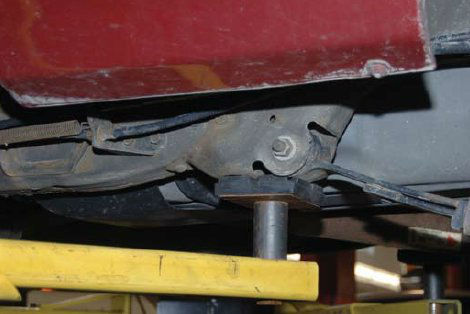 1. Think about the center
1. Think about the centerof gravity for the specific
vehicle you’re working
on. Are you lifting a short
wheelbase roadster, a
passenger car, a stretch
limousine, or a plumbing
truck?
2. Think about the contents
of the vehicle you’re work
ing on in terms of balance.
What’s in the truck box?
What’s in the pickup with
the camper cover? What’s
in the trunk of the family
sedan? Could it be bags
of concrete for a weekend
project?
3. Think about the work
you’ll be doing and how
it can shift the weight of
the vehicle. Will you be
removing heavy
components from the
vehicle? Should you use
vehicle support stands to
stabilize the lifted load?
4. Never assume the lift
swing arm restraints
will keep the arms from
coming out from under the
vehicle. If the adapters
aren’t placed on a flat,
level surface, the
horizontal force developed
on the adapter pad can be
greater than the vertical
force applied to it. Swing
arm restraints are only
designed to resist 150
pounds of horizontal force.
5. Take the adapter design
into consideration. Does
your lift have flip-up adapt
ers, screwtype adapters or
stacking adapters? Are
the adapter surfaces steel or rubber?Are there
features on the adapters
that would inhibit lateral
movement? Do you need
to use extenders to prevent
swing arm contact with
sills, rocker panels, pipes,
dams, steps or running
boards?
6. What about lifting on the
spring hangers? The
vehicle manufacturer says
that’s okay in some cases.
If you place the adapter
on the spring hanger,
does the spring rest on
part of the adapter pad?
If the leaf spring is on the
adapter, the vehicle can
walk right off of the adapter
if it is rocked up and down.
After all, a spring is exactly
that, a spring. It isn’t a
hard, flat, level surface.
Further, how many spring
hangers have you seen
that are flat on the bottom
where you’ll be placing the
adapter pad?
Does this seem like a safe
lift point to you? However,
due to the upsweep of the
frame forward of the rear
suspension on some long
wheelbase vehicles, the
front most rear spring
hanger may be your only
practical choice. Certainly
you would not place the
adapter on the frame
upsweep. It is far from
level. If you select the
spring hanger as the lift
point, be sure the adapter
is not supporting the
vehicle on the spring itself
and, always use vehicle
support stands.
7. Never use blocks (wood
or other materials)
between the adapters and
the vehicle lift points, even
if the vehicle manufacturer
recommends them. The
use of blocks can only
lead to instability.
8. Never lift one end of a
vehicle using only two
swing arms of a swing
arm style lift.
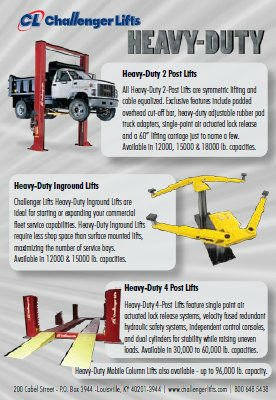 9. If the adapter pads on
9. If the adapter pads onthe lift won’t reach the
recommended vehicle lift
points, use a different lift.
Let’s talk a little bit about
vehicles lifted on the twopost,
fore-and-aft, movable
piston, wheel and axle
engaging lifts. Admittedly
there are far fewer of these
lifts in service than two-post
swing arm lifts but, some
strange things are attempted
on these lifts.
One condition is where
the technician only lifts the
rear of the vehicle to provide
greater access to the engine
compartment. If the front
wheels are free to roll on the
floor, the horizontal forces
applied to the rear jack are
equal and opposite to the
breakaway friction and rolling
friction of the front wheels
(this includes pulling the front
wheels out of the locating
depressions). Doing this will
surely damage the rear jack.
In addition, this force will
increase substantially if the
front wheels are chocked. It
can be seen that as the rear
axle is lifted with axle adapters
or, as the rear wheels are
lifted with wheel adapters,
the vehicle stability will
become solely dependent
upon the security of the
engagement between the
vehicle rear lift points and
the rear lift adapters. Another
condition is where the front
jack and the rear jack are
set at different levels while
supporting the lifted vehicle.

 Automobiles have come
Automobiles have come Our mission at OSHA is
Our mission at OSHA is Automotive lift safety
Automotive lift safety This seemingly tough
This seemingly tough How does the AHJ gain the
How does the AHJ gain the Where do you get your
Where do you get your 1. Think about the center
1. Think about the center 9. If the adapter pads on
9. If the adapter pads on


